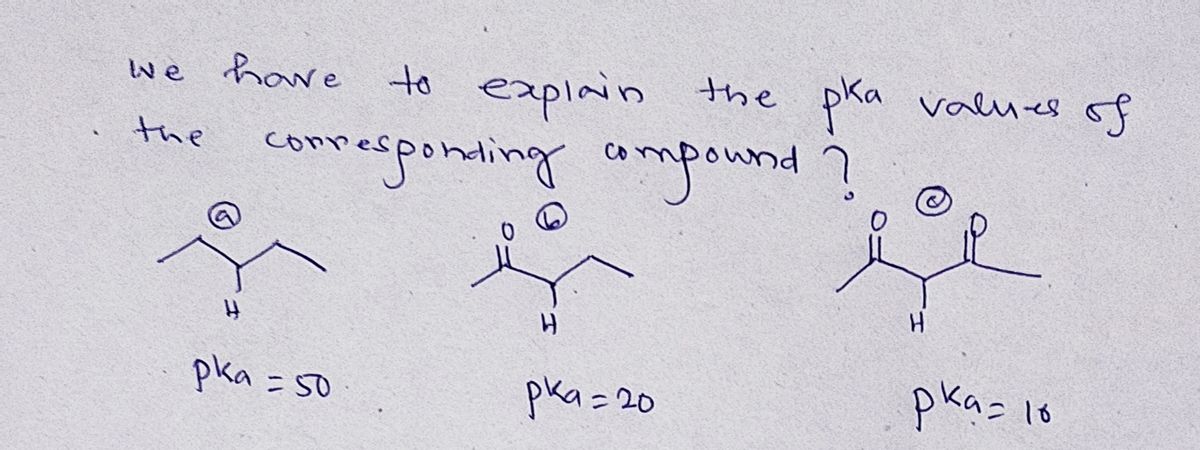Chemistry
10th Edition
ISBN:9781305957404
Author:Steven S. Zumdahl, Susan A. Zumdahl, Donald J. DeCoste
Publisher:Steven S. Zumdahl, Susan A. Zumdahl, Donald J. DeCoste
Chapter1: Chemical Foundations
Section: Chapter Questions
Problem 1RQ: Define and explain the differences between the following terms. a. law and theory b. theory and...
Related questions
Question

Transcribed Image Text:**Question 4:**
Explain why the pKa values of the indicated hydrogen atoms change as they do for these three compounds.
---
**Diagram Explanation:**
The image shows three different organic compounds. Each compound has a hydrogen atom indicated, and its respective pKa value is provided.
1. **Compound 1:**
- Structure: Alkane with a simple carbon chain
- Indicated Hydrogen: Attached to a carbon in the chain
- pKa = 50
2. **Compound 2:**
- Structure: Ketone (carbonyl group present)
- Indicated Hydrogen: Attached to a carbon adjacent to the carbonyl group
- pKa = 20
3. **Compound 3:**
- Structure: 1,3-Dicarbonyl compound (two carbonyl groups present)
- Indicated Hydrogen: Attached to a carbon between the two carbonyl groups
- pKa = 10
---
**Analysis:**
The decreasing pKa values reflect increasing acidity of the hydrogen atoms in the compounds. The differences arise due to the following reasons:
- **Inductive Effect:** The presence of electronegative atoms or groups (such as the carbonyl groups) pulls electron density away from the hydrogen, stabilizing the negative charge that results when the hydrogen ionizes.
- **Resonance Stabilization:** In compound 3, the ionized form of the hydrogen is stabilized by resonance between the two carbonyl groups, significantly lowering the pKa compared to compound 2.
- **Hybridization:** The hybridization of the carbon atom to which hydrogen is attached also affects acidity, with more s-character leading to stronger acids.
This detailed exploration helps students understand how structural features influence acidity in organic molecules.
Expert Solution
Step 1

Step by step
Solved in 2 steps with 2 images

Knowledge Booster
Learn more about
Need a deep-dive on the concept behind this application? Look no further. Learn more about this topic, chemistry and related others by exploring similar questions and additional content below.Recommended textbooks for you

Chemistry
Chemistry
ISBN:
9781305957404
Author:
Steven S. Zumdahl, Susan A. Zumdahl, Donald J. DeCoste
Publisher:
Cengage Learning

Chemistry
Chemistry
ISBN:
9781259911156
Author:
Raymond Chang Dr., Jason Overby Professor
Publisher:
McGraw-Hill Education

Principles of Instrumental Analysis
Chemistry
ISBN:
9781305577213
Author:
Douglas A. Skoog, F. James Holler, Stanley R. Crouch
Publisher:
Cengage Learning

Chemistry
Chemistry
ISBN:
9781305957404
Author:
Steven S. Zumdahl, Susan A. Zumdahl, Donald J. DeCoste
Publisher:
Cengage Learning

Chemistry
Chemistry
ISBN:
9781259911156
Author:
Raymond Chang Dr., Jason Overby Professor
Publisher:
McGraw-Hill Education

Principles of Instrumental Analysis
Chemistry
ISBN:
9781305577213
Author:
Douglas A. Skoog, F. James Holler, Stanley R. Crouch
Publisher:
Cengage Learning

Organic Chemistry
Chemistry
ISBN:
9780078021558
Author:
Janice Gorzynski Smith Dr.
Publisher:
McGraw-Hill Education

Chemistry: Principles and Reactions
Chemistry
ISBN:
9781305079373
Author:
William L. Masterton, Cecile N. Hurley
Publisher:
Cengage Learning

Elementary Principles of Chemical Processes, Bind…
Chemistry
ISBN:
9781118431221
Author:
Richard M. Felder, Ronald W. Rousseau, Lisa G. Bullard
Publisher:
WILEY